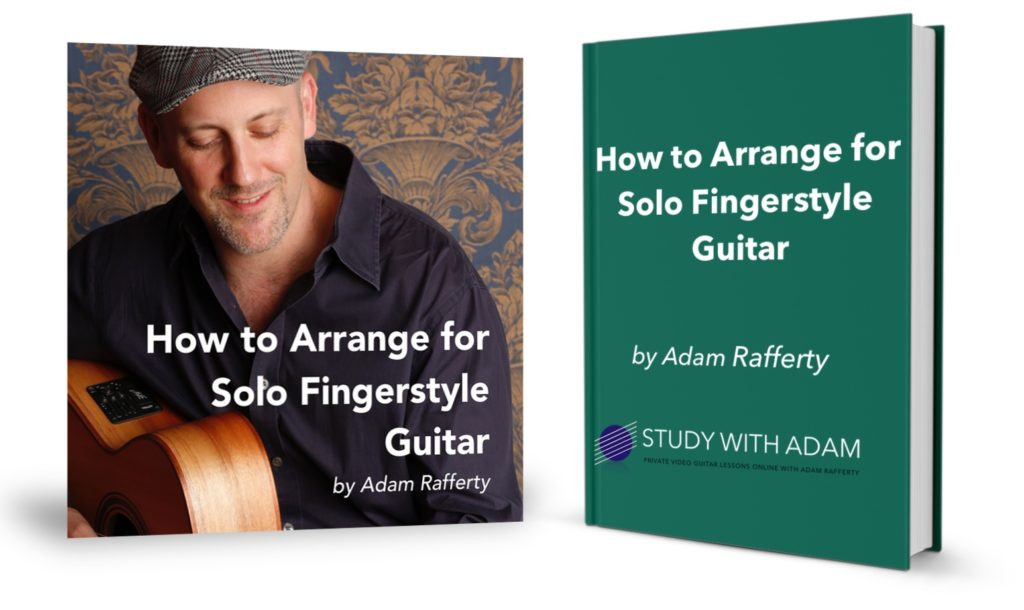Hey Guitar Players!
Ever wondered how to transform your favorite songs into stunning fingerstyle guitar pieces? I often get asked about my approach to fingerstyle guitar arranging, and I’ve realized a simple shift in perspective can make all the difference. This idea might just be the “AHA!” moment you need to elevate your fingerstyle playing.
Just a quick disclaimer – there are many paths to creating a great fingerstyle arrangement. This is one method that I find myself using most of the time, about 90% of my projects.
Breaking Free from Chord-Based Fingerstyle
Many guitarists start their fingerstyle journey with a chord-centric approach. This often involves playing chord shapes and then adding simple picking patterns, sometimes resulting in melodies that feel “tacked on” rather than integrated.
Think about playing a C chord in open position. You might experiment by lifting your first finger on the B string or adding your pinky to the high E string to create a little melodic interest. If you’ve done this, you know exactly what I’m talking about.
To truly understand a more effective way to arrange Fingerstyle Guitar Songs, we need to move beyond this idea of simply “jimmying melodies on top of chords.”
The Melody-First Approach to Fingerstyle Guitar Songs
Melody is paramount. What does this mean?
Growing up, I was captivated by Jimmy Page’s guitar solos (back when I had more hair, I dreamed of being him!). Later, I fell in love with the playing of George Benson and Wes Montgomery, not to mention countless jazz greats – horn players, pianists, singers, and more.
When you listen to someone playing only the melody, without any fingerstyle accompaniment in mind, you realize that a truly captivating melody possesses key qualities:
- Lyricism and singability
- The soulful feel of the Blues (depending on the song’s style)
- Rhythmic accents that perfectly fit the genre
- A rich, full tone and expressive touch
- The ability to resonate with listeners emotionally
Melodies should “sing.” There’s a world of difference between playing a single-line melody that moves people and simply “plunking out notes.” To achieve this, you might need to venture beyond the lower frets – don’t be afraid to explore past the 4th fret and higher!
Imagine you’re playing a lead guitar melody, focusing solely on that melodic line. You need to infuse it with feeling, using bends, slides, and vibrato to make it truly sing. It often takes significant practice to find your personal “interpretation” of a melody.
Consider these examples of “lyrical melody playing”:
- George Benson – “Breezin’” & “This Masquerade”
- Wes Montgomery – “What’s New”, “Portrait of Jennie”
- Jimmy Page – “Stairway To Heaven”, “Since I Have Been Loving You”
None of these are cold, mechanical melody renditions. They are full of heart and emotion, infused with a sense of “love.”
By the way, I have a comprehensive new course, “How to Arrange for Fingerstyle Guitar” PDF and Audiobook, which dives deep into all these concepts. It’s available instantly at StudyWithAdam.com, and you can even try it out with a free 14-day trial. Sign up, download the course and audiobook, and start learning right away!
 Adam Rafferty's Fingerstyle Guitar Arrangement Course Covers
Adam Rafferty's Fingerstyle Guitar Arrangement Course Covers
Grab this course FREE in the Study With Adam 14 day Trial
Step 1 – Make Your Melody “Sing” for Fingerstyle Guitar Songs
This is your crucial starting point. Play the melody of the song you want to arrange completely solo, without any accompaniment. Focus on making it sing. Don’t be afraid to break conventional rules you might have learned.
For example, consider if a note “sounds” better on the B string, even if it might be technically easier to play on the E string.
Always choose the option that sounds best, sings most expressively, and will move the listener – rather than the easiest or most convenient fingering.
Listen to your own playing with your heart, not just your head.
Pay close attention to rhythmic accents. Are you placing them precisely where they should be? Yes, capturing syncopation and nuanced phrasing can be challenging, but don’t take shortcuts!
Get that melody sounding as close to the original as possible, or as close to your ideal interpretation. Don’t settle for less than your best melodic expression.
No matter how intricate or clever your fingerstyle arrangement becomes, if you neglect the crucial step of crafting and performing a great melody, your arrangement will ultimately fall short. Many fingerstyle players unfortunately don’t dedicate enough attention to this foundational element.
Step 2 – Lay Down Your Bass Line Foundation for Fingerstyle Songs
Now, with that singing melody in place, it’s time to introduce the bass. Use any available finger or open string to try and play the root note of the chord, ideally on beat one of each measure, while simultaneously maintaining that lyrical, expressive melody.
Resist the urge to immediately jump to full chord shapes. Instead, prioritize the melody and add just the bass note.
As this foundation develops, explore adding a rhythmic element with your right-hand thumb, playing alternating bass notes against the melody. Some rhythmic combinations might initially feel tricky.
You may need to find new left-hand fingerings for the melody to accommodate the bass notes, but strive to preserve the original melodic feel as much as possible.
Step 3 – Fill in the Harmonic Middle Ground for Fingerstyle Guitar
Without sacrificing the lyrical quality of the melody or the firmness of the bass line, now look for opportunities to add one or two notes from the chords in the “middle” register.
Think of this middle part as “subservient” to the melody. Imagine the melody as the main voice, and the middle harmony notes as a subtle, supportive response, like a servant quietly affirming “yes” in the pauses. That’s the role of the middle harmony – to enhance and support the melody without overshadowing it.
Step 4 – Let Your Fingerstyle Arrangement “Cook”
As you integrate the melody, bass, and middle harmony, the arrangement will slowly start to take shape. Aim for your unique blend of lyrical melody, rhythmic groove, harmonic support, and playing comfort.
The separate parts will gradually “blend” together, and you’ll begin to hear it sounding like a complete, cohesive fingerstyle arrangement.
Any questions?
RELATED: 10 Tips for Healthy Guitar Practicing
Ready to take your fingerstyle guitar journey to the next level and master fingerstyle guitar songs?
Learn fingerstyle guitar from a world-class guitarist and teacher. Let Adam guide you and show you exactly how to improve your guitar skills. Grab this rare opportunity to Study With Adam FREE for 14 days, right now!

